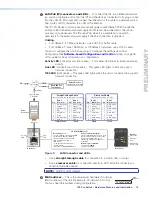
IPL Pro Series • Reference Information
25
HTTP (Hypertext Transfer Protocol)
A network protocol based on TCP/IP that is used to retrieve hypertext objects from remote
web pages and allows servers to transfer and display web content to users.
HTTPS (Hypertext Transfer Protocol Secure)
A communications protocol for secure communication over a computer network. It allows
web servers to transfer and display web content to users securely. All transferred data
is encrypted so that only the recipient is able to access and read the content. It is not a
protocol, itself, but rather a combination of Hypertext Transfer Protocol (HTTP) on top of
the SSL/TLS protocol, which adds the security capabilities of SSL/TLS to standard HTTP
communications.
ICMP (Internet Control Message Protocol)
ICMP is an Internet protocol is used by network devices (routers, switches, and the like)
to send error messages or relay query messages. Typically ICMP messages are used
for diagnostic or control purposes or are sent to the source IP address in response to IP
operations errors. Error messages include notices that a device is not available or that a
host or router could not be reached.
IP (Internet Protocol)
The protocol or standard used to send information from one computer to another on the
Internet.
IP address
A unique, 32-bit, binary number (12 digit decimal number, xxx.xxx.xxx.xxx) that identifies
each device or device port (an information sender and/or receiver) that is connected to
a LAN, WAN, or the Internet. IP addresses can be static (see static IP) or dynamic (see
DHCP
).
IP net mask/subnet mask — See subnet mask.
MAC (Media Access Control) Address
A unique hardware number given to devices that connect to a network such as the Internet.
When a computer or networking device (router, hub, interface, and the like) is connected
to a LAN or the Internet, a table (which is used in ARP) relates the IP address of the device
to its corresponding physical (MAC) address on the LAN. This protocol allows for several
terminals or network nodes to communicate within a multi-point network, typically a local
area network (LAN).
NTP (Network Time Protocol)
NTP is an Application layer networking protocol that synchronizes clocks among computers
and other devices over networks.
Ping
A utility/diagnostic tool that tests network connections. It is used to determine if the host
has an operating connection and is able to exchange information with another host.
Port number
A preassigned address within a server (such as the control processor) that provides a
direct route from the Application to the Transport layer or from the Transport layer to the
Application of a TCP/IP system.
SFTP (Secure File Transfer Protocol)
Similar to FTP, this protocol adds encryption and requires credentials for file transfers.
SMTP (Simple Mail Transfer Protocol)
SMTP is an Internet standard for e-mail transmission. By default, SMTP uses TCP port 25.
SMTP connections secured by SSL, known as SMTPS, default to port 465.
SNMP (Simple Network Management Protocol)
SNMP is an Application layer protocol that facilitates the exchange of basic network
management information between network devices. It helps in monitoring of operations and
factors such as bandwidth, memory usage, remote password resets, and collection of error
information. This protocol collects (and configures) information from network devices (such
as servers, hubs, switches, and routers) on an Internet Protocol (IP) network.
PRELIMINARY









































